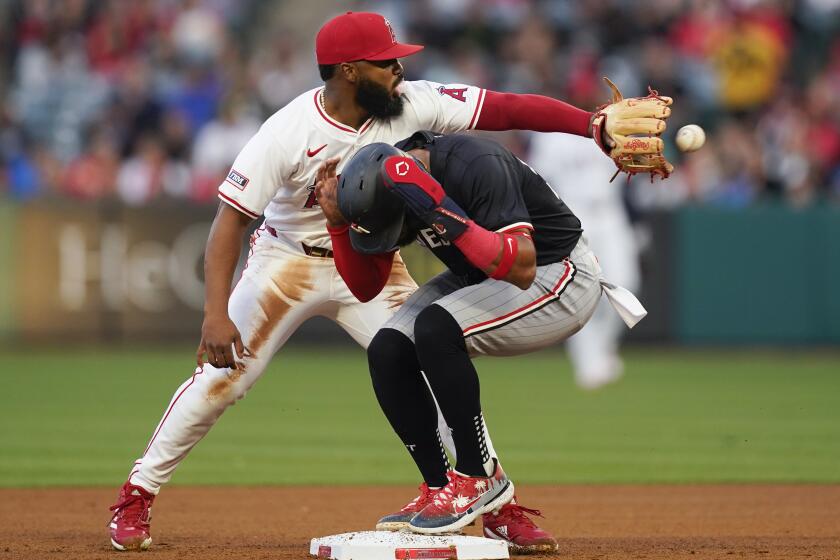Some Believe Baseball Draft Is All Fouled Up
Jered Weaver has no business pitching for the Angels. The Angels’ scouting director will tell you that.
They’re thrilled to have him, to be sure. But as the annual baseball draft takes place today, Weaver’s presence on the Angels indicates the draft is not fulfilling its purpose.
“If the draft was put in place to give teams that had a poorer season the chance to draft the best players, then obviously it’s a little off track,” Dodgers General Manager Ned Colletti said.
The baseball draft is a virtually invisible event, conducted by conference call rather than staged by ESPN. There is none of the intrigue that surrounds the NFL draft, in part because baseball draftees immediately disappear into the minor leagues, and many never surface in the majors.
And baseball teams cannot trade picks, so the draft proceeds at lightning speed. The first pick goes to the team that had the worst record the previous year, but Eddie Bane, the Angels’ scouting director, says recent history shows that the worst team does not necessarily take the best prospect.
“We have agents that try to dictate where their players are going to go,” Bane said. “They want them playing for guys like us, which is fine with us, but that doesn’t serve the purpose.”
Bane did not identify an agent by name, but he did answer the question of whether he was referring to any agent besides Scott Boras.
“I don’t see anybody else’s guys not signing,” Bane said.
That brings us to Weaver, and to Luke Hochevar, both represented by Boras. Weaver, ranked by Baseball America as the top pitcher available in the 2004 draft, was not selected until the 12th pick, by the Angels. He held out one year, then signed for $4 million, the top bonus of any pick in that draft.
Hochevar, ranked as one of the top two pitchers available last year, was not selected until the 40th pick, by the Dodgers. He held out one year, turned down $2.98 million and did not sign, and is expected to be picked by another team today.
The top pick last year, shortstop Justin Upton, held out for six months, then signed with the Arizona Diamondbacks for $6.1 million. He is not represented by Boras.
But Boras is not shy about identifying what he evaluates as premium talent, then advising those players to sit out a season if a team declines to pay a premium price. If teams pass on such players because they consider the asking price excessive or won’t risk a lengthy holdout, he says, then so be it.
“They have every right to draft the players they want to draft,” Boras said. “In the end, it’s the club’s choice.”
Said Minnesota Twins General Manager Terry Ryan: “You’re not going to take a player who doesn’t want to be with you.”
With baseball funneling millions of dollars to small-market clubs via revenue sharing, Boras says, any team can afford to sign the best player available. It’s not his fault, he says, if teams shy away from his clients, and if those players fall to the best teams.
“John Elway’s representatives said he didn’t want to play in Baltimore. Danny Ferry’s representatives said he didn’t want to play for the Clippers,” Boras said. “The representative’s job is to represent the interests of the player.”
In the interests of the game, however, Boras suggests a new rule: Teams can trade the players they draft.
“If they truly wanted the draft to have the best player go to the worst team, they would invoke that rule,” he said.
In 2004, the San Diego Padres had the top pick but passed on Weaver, citing Boras’ original asking price, in the $10-million range. They picked shortstop Matt Bush and signed him for $3.15 million.
“If we thought there was a player worth $10 million in this draft, we’d give it to him,” Padres General Manager Kevin Towers told the San Diego Union-Tribune at the time.
Baseball rules forbid trading a drafted player until one year after he signs. Under Boras’ plan, however, the Padres could have picked Weaver, then traded his rights for players, cash or both.
“Then the team gets something for the best player in the draft,” Boras said.
Bane works for a large-market team and Ryan for a small-market team, but both said Boras’ concept would exacerbate the problem, not solve it.
“We’re dead set against that,” Ryan said. “The large-market teams would end up with a majority of the top picks.”
Said Bane: “I think that’s a bad idea. You know who they would trade the pick to? The ones that could afford to have it.”
A top draft pick is a high-priced best guess. Alex Rodriguez, Ken Griffey Jr. and Darryl Strawberry were No. 1 picks. So were Jeff King, Shawn Abner and Steve Chilcott, better known as the guy the New York Mets took instead of Reggie Jackson. In 1990, when the Atlanta Braves weren’t sure they could sign Todd Van Poppel, they settled for their second choice, Chipper Jones.
For now, the Angels are delighted with Weaver, and vice versa. The Angels promoted him last month, after only 23 minor league starts. In his first two major league starts, he is 2-0 with a 1.35 earned-run average.
“I could have been a higher pick,” Weaver said. “It didn’t work out, but I was lucky enough to get swooped up by the Angels. I’m happy with the way things worked out.”
More to Read
Go beyond the scoreboard
Get the latest on L.A.'s teams in the daily Sports Report newsletter.
You may occasionally receive promotional content from the Los Angeles Times.






